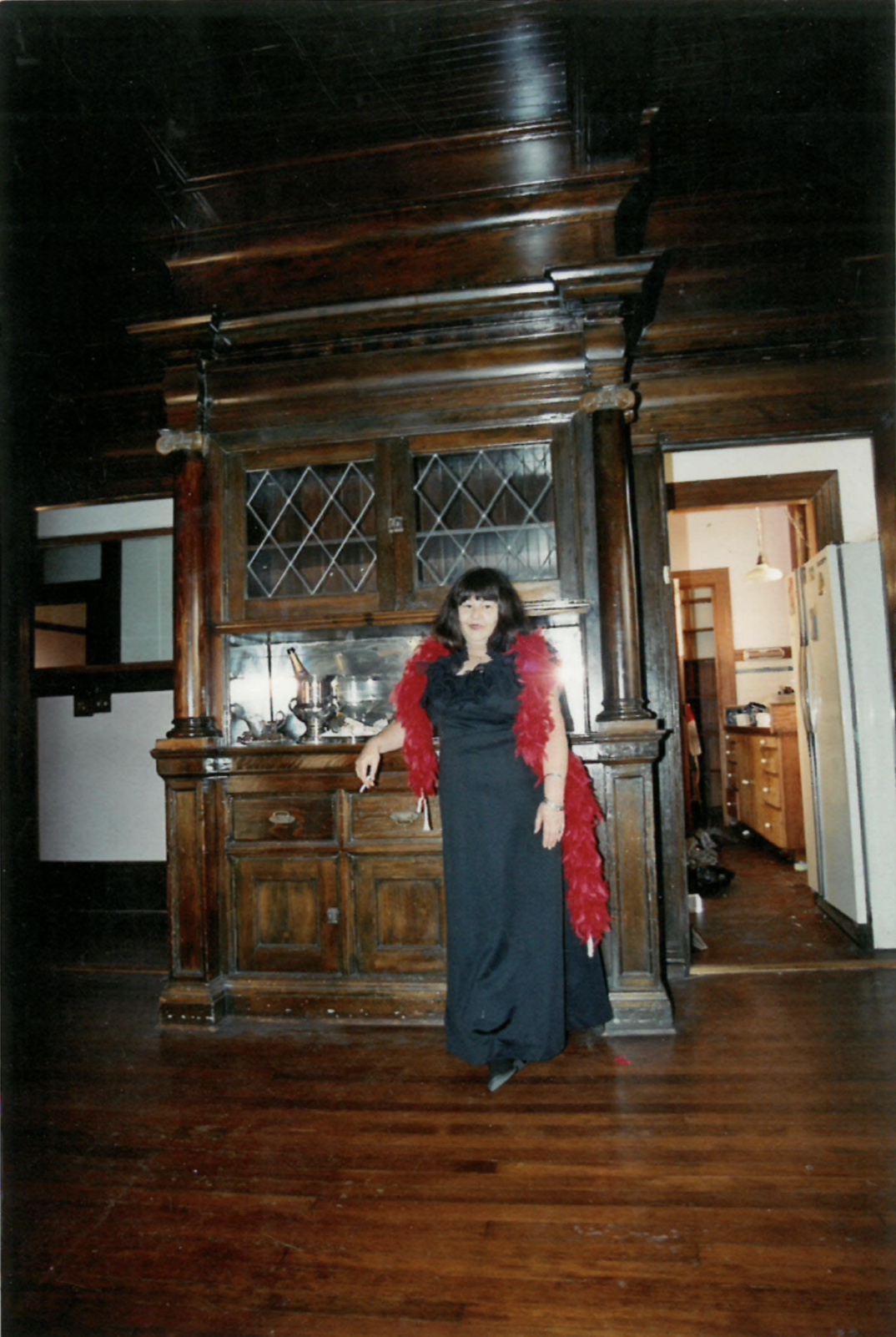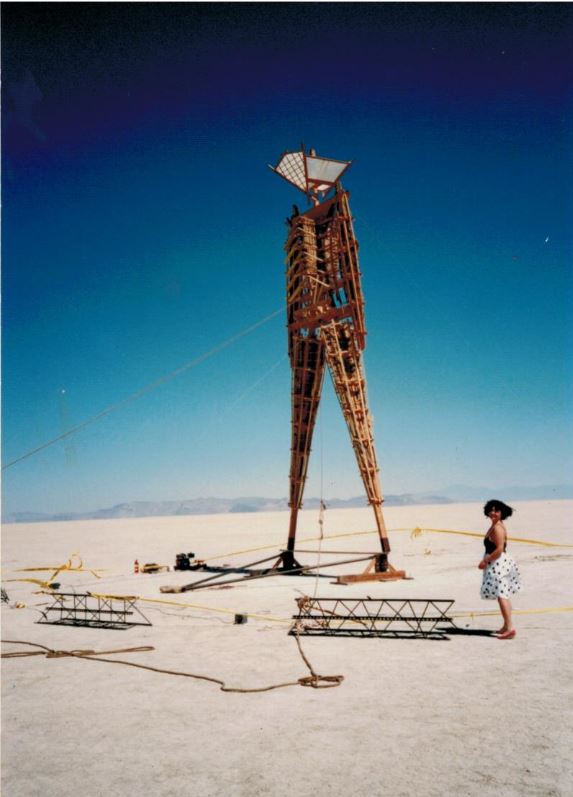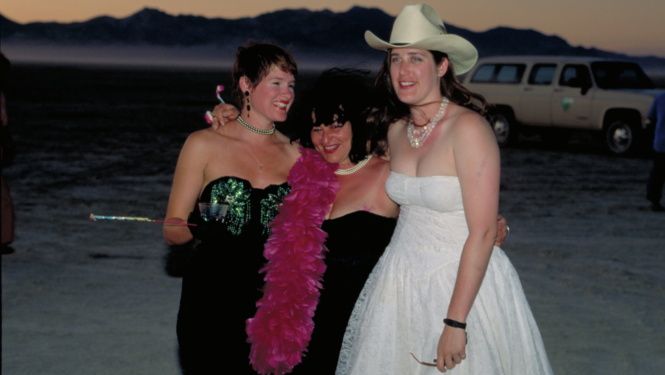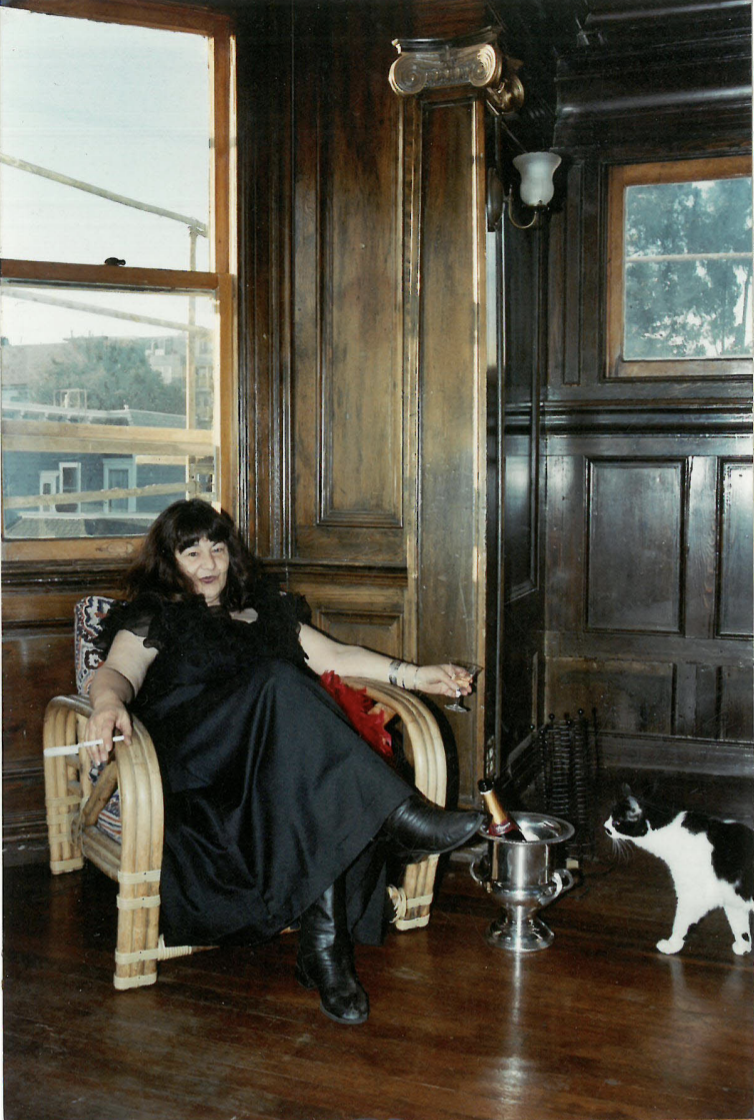P Segal has been an instigator in San Francisco’s underground art scene for decades. She led Burning Man’s move from Baker Beach to the Black Rock Desert and started Black Rock City’s Center Camp Cafe. Her home at 1907 Golden Gate was a hub for Cacophony Society rabble-rousers and Burning Man founders, who gathered there for raucous parties, Proust tributes, and late night Burning Man planning sessions. We spoke with P about the creative and economic conditions that made possible those wild, heady days — and Burning Man — possible. We heard about her ongoing work to create affordable housing for artists, and learned why the person ultimately who brings the artists back to San Francisco will be a hero.
Kirsten: We often hear your name in relation to a magical house where the Cacophony Society gathered in the 1980s and 1990s. Can you tell me about 1907 Golden Gate (aka 1907)?
P: The years in that place were wildly creative times. The city was so cheap, I could rent an enormous two-story flat for $1,100. We could all work part time and spend most of our lives devising spectacular events and doing art, writing, making music.
1907 was Cacophony’s unofficial clubhouse, where every night there were people gathered around the kitchen table dreaming up wonderfully bizarre, imaginative things to do. We invited the world to join us, through the newsletter we left in cafes and bookstores all over town, Rough Draft. And we had a 4,800 square foot flat in the inner city, with an all redwood back parlor, to do it in—which is where we planned Burning Man for the first few years.

One of the roommates at 1907 had this friend who is a conceptual artist. He gave this one event out at the playa—a 22-times-larger-than-life croquet game. Two years later he did a wind sculpture festival and anyone could go—you just had to bring something that moved in the wind. We made a canopy bed on wheels out of PVC, wire, and fabric and went out to the playa for the first time in 1989.
The very next year you started hatching plans to bring the Man to the Black Rock Desert. How did that come about?
Four members of the 1907 household, all members of Cacophony, went to the wind sculpture festival, and were, of course, stunned by the playa. One of the housemates, artist Kevin Evans, decided to do one of the classic Cacophony events, a Zone Trip, to take people out to the playa the next year, for an event called Bad Day at Black Rock.
That was, of course, the year when the park police stopped the Burn [on Baker Beach]. So my friends and I said, “We know what to do now.” And Larry Harvey was saying, “Well, I don’t know, it’s weird. And it’s far.” And I said, “You’ll love it. You’ll love it.”
We started meeting in the back parlor in 1907 to talk about exactly what to do, how to make it happen. We had three months to plan moving the Burn to the playa for Labor Day weekend.
That house was just such a phenomenal hub for a lot of wildly creative stuff. And I really miss it. The only unfortunate result of Burning Man at the playa, which we knew from the first Burn would be an annual event, was that it more or less killed Cacophony. We no longer planned events to do in town; we spent all our time planning what we’d do on the playa.

What is the biggest, most enduring thing you gained from your experience and history with Burning Man?
Maybe it’s because art is such a dominant force in my own consciousness, but I’d say that my Burning Man experience taught me how important art, ritual, and beauty are for human society.
People don’t go out to the middle of nowhere because it’s a camping trip for 80,000 people. What has compelled people to go, since the beginning, is the wildly aesthetic, ritual spectacle, and all the rest of the visual feast. In that shared wonder over the extraordinary thing—things!— they’ve experienced together, an affinity grows between people who might never be connected otherwise.
Burning Man has its own rituals, like the driving of the spike to mark the center that the city will be built around, the Lamplighters illuminating the city at dusk, the silent, reverent burning of the Temple, and of course, the Burn itself. These are things of ritual and beauty that make people want to come back every year.

But you’ve moved on from Burning Man these days. What are you currently working on?
Larry said to me one time: “You don’t have to go to Burning Man anymore. You know what it is. You live that way.”
It was a different kind of fun in the beginning, when we were inventing it all as we went along. Keeping an established format operating is a particular skill. I’m one of those people who likes to start things.
I’ve watched San Francisco, this phenomenally creative place I’ve lived in all my life, devolve into a corporate one, with absolutely no respect for the creative class that made it beautiful, charming, and bohemian. The artists who spent more than half their income on rent, and most of their time creating things that gave others pleasure—like Burning Man—are no longer welcome here.
My job now is to make people understand why artists are essential parts of the social fabric and make it possible for them to stay in this place they love and call home. For the last six years, I’ve been trying to find a way to create artists’ housing in the city. I’ve been imagining buildings full of creative people where we could recreate the spirit of 1907. And to do so, I devised a new model for co-op artists’ housing and venues.
The nonprofit behind it is called ArtHouse. Can you tell us a little more about what you’re doing there?
The pandemic created a new playing field in this city. There are so many vacancies. I’ve been looking around at this devastated city with all these commercial districts that are just rows of boarded up storefronts, and imagining what creators could do in those spaces.
We know that people buy buildings to offset capital gains, leave them empty to show losses, and make them easier to sell. So I’m saying to investors: You’re buying that property and you’re leaving it empty. You could be leasing it to us for a dollar a year, with the contractual understanding that we’ll buy the building at some agreed-upon time for the standard social impact investment rate of return.
This is unquestionably a legacy investment—because the person who brings the artists back to San Francisco is going to be a hero. If you have lived in San Francisco long enough, you know that the minute a bunch of artists move into a derelict neighborhood, it becomes fashionable. The ArtHouse model revives neighborhoods, while protecting artists from displacement, gives the city back its soul, and provides a fresh way to conceive of housing.
We of course need basic funding to pursue this goal, and welcome all donations. You can donate here. Or if you work for an organization that handles donations through Benevity, you can find us listed under our fiscal sponsor, Intersection for the Arts.
What lessons do Black Rock City and Burning Man culture offer for cities?
The first principle, the gifting economy, is a powerful tool for building a healthy society. When everyone gives something to the whole, there’s less want and deprivation, and everyone has the satisfaction of being part of a smoothly functioning social order. There are so many ways to give, and anyone can afford the gift of kindness.
There’s pride in being part of the Burning Man community because Black Rock City has a staggering wealth of spectacular beauty. People are proud to live in places that are full of visually amazing things, like San Francisco, Venice, Florence, Paris… It creates that unconscious sensibility that you’re part of that beauty, being part of that place.
Beyond San Francisco and the particular challenges it faces, what would you say to residents of other cities who want to bring the connectivity of art into their local communities?
Most older cities have at least one empty white elephant, like a somewhat derelict mansion, or an industrial space. I’d say, turn those empty spaces into artists’ housing, and make long-term fellowships available for artists from elsewhere, in exchange for creating public art and events.
I know this is not only possible, but happening, in the small city of Dubuque, Iowa, on the Mississippi River. A few years ago, I made the online acquaintance of a member of the Burning Man community, Mike Muench. He flew me to Dubuque, where I spent a few days with him and his extraordinary friends, and spoke about artists’ housing at a meeting of city officials and people in the arts community.
Dubuque has a fantastic area called the Millworks District, blocks of elegant 19th century brick mills, which were once a center of production on the river. When I got there, most of those buildings were empty, but Mike had bought one of them, with the intention to install an ArtHouse. Since my visit, the city has developed these beautiful old empty buildings. When you install artists in an unused space, it becomes—not at all surprisingly—the coolest place in town. ArtHouse is made up of people in the arts, fighting to remain in San Francisco. By partnering with property owners to inhabit empty investment properties, they hope to create nonprofit co-op housing and venues for artists, writers, and musicians.
ArtHouse is made up of people in the arts, fighting to remain in San Francisco. By partnering with property owners to inhabit empty investment properties, they hope to create nonprofit co-op housing and venues for artists, writers, and musicians. Donate to ArtHouse here.
Cover image of Harley K. Dubois, P Segal, and Dawn Stott, 1991 (Photo by George Post)



My days in the city are pretty hazy but i remember getting coffee in the mornings with my good friend Flecher Fleudajon at Caffe Proust, an amazing place. I think there must be a connection. Thank you P Segal for everything.
Report comment
You’re so welcome, and I look forward to giving you more! Thanks for coming to Caffe Proust!
Report comment
I know a man…who may love to hear this story and work with P. Segal…He is just the kind of person who does what she speaks of. He buys run down buildings, renovates them and turns them into artist studios and rents the space out to artists…who don’t actually live there, but work and create there. One of his properties is in San Pablo…where the building has a cool little restaurant where the artists (of ALL mediums) can showcase their work. Most of his tenants are people down on their luck needing a second chance in life, and he get down in the work with them to build and create the space for them…he happens to be one of my all time favorite people. Last I heard, he was on the board of directors for the Exploratorium in SF…a wealthy man with a heart of gold and a great mind to match it…unheard of in these times…pls contact me privately, for his info, if interested in connecting with him. His name is Eddie.
Report comment
This is fantastic, and yes, I would love to meet him! And you! Thank you so much for this bit of wonderful news. You can reach me at mspsegal (at) gmail.
Report comment
Wonderful to read this!
Report comment
Thanks, and yes, new thinking for the Aquarian Age, which actually starts next January!
Report comment
There will soon be many abandoned prisons, all across America. I wonder…poetic justice?
Report comment
One of my old friends and BM mischief makers, Chris Radcliffe, talk the government in Portland into turning an unused prison into homeless housing. So yes.
Report comment
I credit, with immense gratitude, Ms. P Segal for my life and career in San Francisco; I owe it ALL to her! I went to my first Burning Man in 1995, and met P when she was struggling with her single espresso machine in her tiny cafe under a parachute; we began talking and I told her I’d recently moved to SF from NYC. She said, ” If you want to have more fun here, join the Cacophony Society.” So I did, and by the end of that year I had met Larry, Harley, Danger , Crimson and all of the Burning Man instigators. I started going every year, and in 1999, the art grant program was created and Larry hired me to run it. Thus began my 24 year tenure with the Org and my devotion to all things playa. I credit all of this to Ms. P and her inspired community centered at 1907 Golden Gate. THANK YOU MS. P!! and Thank you Larry.
Report comment
Meeting you was one of the finest moments of all those years on the playa.
Thank you for being such a wonderful friend and ally all these years! xoxo
Report comment
Trans women are brave!
Report comment
All Hail P Segal! Cafe Proust was an alembic crucible that nourished a community spirit. Black Rock City is proof supporting creatives works. ArtHouse is a concept to keep the spirit growing in communities where we live. Burn Local.
Report comment
Dr, Really?, you’re a wonder.
Report comment
I love you, Ms P! So many fond memories of wild shenanigans at 1907! Thanks to your Proust Wake, I first had absinthe and discovered my life purpose. You have given this community so much! I’m excited for ArtHouse! Congratulations and best of luck
Report comment
I’m so glad to have given you something to do so beautifully and well! We did have an amazing time at 1907 all those years, and I want to do that again!
Report comment
This is wonderful work that you are doing. San Francisco has always had an active art scene and needs it now more than ever. I will never forget the Proust Wake at the Wickett Museum. Absinthe with little slotted spoons and Madeleines, just WOW!
Report comment
It’s time for P Segal’s vision of creating ArtHouse in San Francisco in NOW! Especially with all the empty buildings and all who in need for housing. It’s a fact when artists move into a neighborhood they will transform it for the better. I have experienced this, having the great fortune to be living in Westbeth, the first federally funded artist housing. Fifty years ago, living in this neighborhood adjacent to the meat packing district was a dark, scary, rundown place with piers along the Hudson River burning and the Westside Highway falling down. Now it’s NYC’s upscale trendy neighborhood with the Whitney Museum, the Highline and the beautiful Hudson River Park. This is an excellent example for SF to wake up and support ArtHouse. P Segal has been carrying the torch for years – now it’s time for her dream to become reality!
Report comment
Comments are closed.